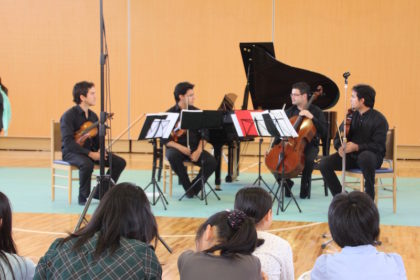
A string octet from the Philippine Sistema-inspired program Ang Misyon visited the U.S. in June for its first “International Awareness and Education Tour;” performing along with them was the program’s founder/director, pianist Jovianney Emmanuel Cruz. I met these dedicated young musicians and their colleagues in the Orchestra of Filipino Youth in the Philippines last year, and one of my most vivid memories is of standing with them in the wings of a cavernous theater, watching Jovianney, alone at the piano between orchestral numbers, play Leonard Bernstein’s piano transcription of Copland’s Rodeo. At the end of the piece, Jovianney played the final low octave-crash so hard that he propelled himself off the bench – and I felt the kids around me forcefully and collectively levitate along with him. It was as though they were inhabiting the music by virtually inhabiting their teacher.
This memory leads me to another, of a recent Skype conversation I had with vocal teacher Daniel Soren at the Sistema-inspired program Orquestrando a Vida in Campos, Brazil. Daniel told me that every other year, faculty members and guest pro fessionals sing the lead roles in the annual opera production; in alternate years, the students sing the leads. He explained that while it’s important for kids to sing those roles, it’s equally important for them to hear professionals sing them. “The kids form the chorus, and so they stand onstage with the pros, experiencing our work,” Daniel told me. “They hear the sound up close; they feel it in their bodies. It gives them sonic models to emulate.”
So here’s my question to teaching artists: do your students hear you perform often enough? I don’t mean the D scales and the “Go Tell Aunt Rhody’s” you play along with them – although those are certainly crucial in developing their sonic awareness. I mean the experience of hearing you play the music you play professionally, passionately, alone or with your colleagues. I think this sharing of your own sounds and skills is an essential element of teaching artistry, one that can contribute immensely to your students’ musical growth. But very often it gets skipped, in the interest of maximum playing time for the children.
We like to encourage our students to think of performing as an act of generosity, of sharing. Don’t forget to be generous with your own artistry. Your students are hungry to absorb, emulate and internalize the music you love to make.
— Tricia